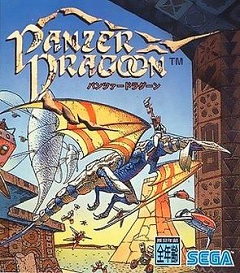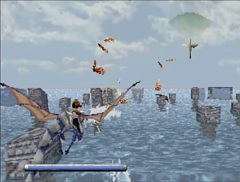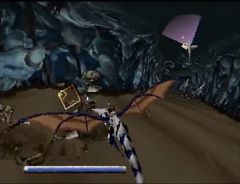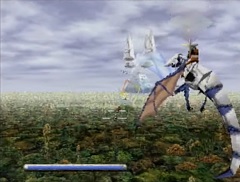
Panzer Dragoon
When rail shooters rose to prominence in the 1980s, Sega quickly established itself as one of the most talented developers out there for this sort of game. They dominated arcades with the likes of Afterburner, Space Harrier, and Galaxy Force. Fast forward about a decade and the genre was starting to feel long in the tooth for a lot of people. However, Sega once again stepped forward and proved that this sort of game still had legs. When Panzer Dragoon came out in 1995 on the Saturn, the game turned a lot of heads and became an instant classic.The game took place in the distant future after humanity had a massive war with the genetically engineered beasts they had created. When the dust settled, the population was split between dwelling in small villages and massive cities. One group would rise above the others, though: a nation simply called the Empire. Its people had the good fortune of stumbling across powerful technology of the past and used it to push back many of the dangerous monsters roaming the world. As time passed, though, its people became corrupted by this power and became conquerors rather than liberators. Amidst all this was a young man named Keil Kluge who, while wandering the countryside eventually found himself psychically bonded with a blue dragon after its original rider was killed. The dragon was trying to stop another larger, black dragon from reaching a black tower. With its rider dead, it implores Keil to help, and the man agrees with the two setting off in pursuit of the black dragon. From here, the game begins with the player helping them complete their task.
As players were taken along each stage’s pre-determined flight path they would have Keil’s gun and the ability to shoot blue dragon bolts at enemies. A nice feature of Panzer Dragoon was the ability to rotate the camera 360 degrees, allowing for shooting enemies trying to sneak up from behind. Rail shooters had traditionally focused on enemies coming at the player from up ahead, slowly appearing on the horizon, then swooping in for the kill. Here, players needed to be wary of an attack coming from anywhere, heightening the excitement quite a bit while traversing each stage. As such, there was a lot going on with tons of enemies and each stage being punctuated with a boss fight at the end.
Visually, the game looked very good for its time. Enemy designs were quite interesting as were Keil and his dragon. People and architecture both had a distinctive look to them. Jean Giraud did the cover art for the Japanese version of the game, and it appears that the folks at Team Andromeda were influenced by his work when bringing Panzer Dragoon’s art direction together.
The game as released at the dawn of a new console war and Sega was keenly aware that with Sony about to throw their hat into the arena, they needed to make a splash with Panzer Dragoon’s graphics. Sega chose to focus on what could really make their game stand apart from anything that might appear on the PlayStation. As such, it had what the developers dubbed an “infinite plane”. This was because the hardware in the Saturn was setup such that it could have textures that extended all the way to the horizon, making for a very unique visual experience. That is why players will notice that the horizon plays such a prominent role in the aesthetic of each stage of Panzer Dragoon.
For the time, it looked quite nice. This isn’t to say that the game was nothing but horizons everywhere. Each stage emphasized the collapsed world that Keil and the rest of humanity had to live in. Players flew over vast, sunken cities, forbidding deserts, and through the crumbling remains of ancient facilities. From what one can see in the game, it’s quite clear that humanity has fallen and nature has slowly reclaimed the land over the course of centuries.
The game also has a fantastic soundtrack. It was composed by Yoshitaka Azuma, who, prior to Panzer Dragoon, was largely an obscure ambient electronic artist. His work here proved an interesting change of pace, being much more up tempo with prominent strings interlaced with electronic instrumentation, rock guitars, and whatever else he felt would enhance the experience while players flew their dragon through each stage. He rarely composed music for games, but made a lot of waves with his involvement here. It’s definitely worth tracking down some of his other releases for those curious, as they show a very different side to the types of music he would create as well.
In a lot of ways, Panzer Dragoon marks the beginning of the rail shooter’s last hurray in popular gaming’s zeitgeist. The genre was already on the way out before the game released, but Sega and Team Andromeda made it and its sequels just fresh enough to renew people’s interest in these sorts of games for a little longer. Now, almost a quarter century after its initial release, the game still holds up well and is well worth trying out for those who missed it as well as revisiting for people who haven’t touched it in years.
- IroIro
December 6, 2019
More Rail Shooters that We've Discussed:
- Omega Boost Review (PlayStation)Genre: Rail Shooter
Developer: Team Andromeda
Publisher: SEGA
Released: 1995

JP Saturn Cover Art

Soaring over a flooded ruin

Hovering over a desert

Jungle stage